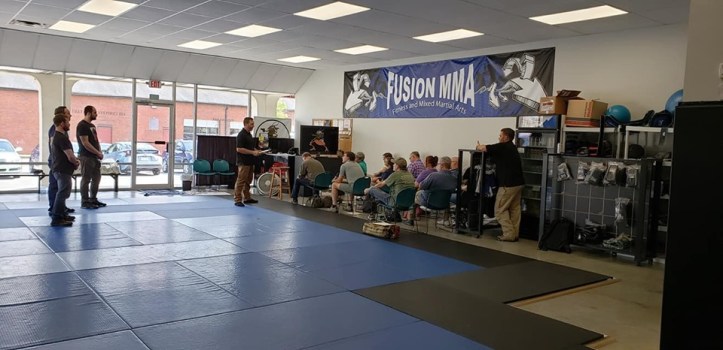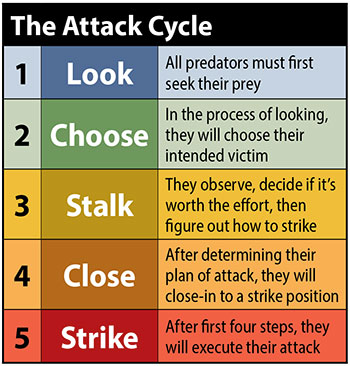In the seven years I went to graduate school to earn a PhD in sociology, I was never taught how to teach. Although most of my peers and I hoped to get positions as faculty members, the PhD is a research-based degree. So it was not until I was a new professor at the University of Notre Dame that I began to learn about pedagogy – the method and practice of teaching.
One of the first things I learned about syllabus design was the need to begin at the end. What is the ultimate goal of the class? Only with that in mind can any teacher begin to put together a course of instruction designed to get the student there. This includes those who teach personal protection.
Brian Hill is owner and head instructor of The Complete Combatant and Fusion Fitness and Mixed Martial Arts. He has been teaching full time since he was a teenager (more than two-thirds of his life) and estimates he has 100,000 hours of teaching under his belt. Or should I say belts – martial arts black belts, that is, of which he has many (Karate – 4th degree, Japanese Jiu-Jitsu – 4th degree, Taekwondo – 4th degree).
Unlike me, Hill learned pedagogy on the job, and he has designed a unique and valuable course called “Force Readiness” which my wife and I took in July.

Hill begins “Force Readiness” as any good instructor should begin a course, with the ultimate goal in mind. In his terms, “Mission success is to get home alive or stay alive at home.”
This is a common goal of firearms training courses. But Hill maintains that having and knowing how to use a gun only solves 1% of the average person’s problems. His “Force Readiness” course does address gun use in part, but the bulk of the class is oriented toward solving – including preventing – the other 99%.
It is a firearms training course that does not require a person to actually fire arms. As such, it provides a model for trainers and students who do not have easy access to live fire ranges. (As I noted recently in reference to The Tactical Professor Claude Werner’s work, the supply of live fire ranges in the more densely populated parts of the country is limited.)

As in medicine, an ounce of prevention is worth a pound of cure, but most gun training courses spend the bulk of their time on the cure – and one cure at that: the gun – to the neglect of prevention. Force Readiness begins with prevention, specifically Steve Tarani’s 5-step attack cycle and how to disrupt it.

Tarani develops the idea of preventative defense or “PreFense” in his book by that title. The whole idea of preventative defense is based on the goal of NOT having to actively defend yourself by recognizing looming threats and avoiding critical incidents, i.e., preventing them from happening in the first place. This goes beyond the mantra “don’t go stupid places with stupid people at stupid times” by allowing us to treat public space not as a battlefield to be negotiated but as a place to be enjoyed.
Although he doesn’t use the term PreFense, Hill teaches skills and tactics in Force Readiness that may allow us to break the attack cycle and succeed in our mission of getting home alive.
1. “LOOK: All predators must first seek their prey.” We break the cycle at this stage by being aware. The most common and significant impediment to our awareness is the ever-present cell phone. Getting that out of our way, especially in transitional spaces, helps us to see what is happening around us. For example, if people are fishing for prey in parking lots or on sidewalks.
2. “CHOOSE: In the process of looking, they will choose their intended victim.” We break the cycle at this stage by de-selecting ourselves. Not having our faces in our phones is a good start here, but so too is carrying ourselves in such a manner (head up, clearly aware) that the potential assailant decides that we’re “too much work.” In low light situations, having a flashlight can signal to an attacker they would be wise to look elsewhere.
3. “STALK: They observe, decide if it’s worth the effort, then figure out how to strike.” Here, recognition that we are being stalked is key to prevention. For example, if we think someone is following us on a sidewalk, we can cross the street and see how the person responds. We may be able to pick up some of the cues that attackers give as to their intentions, such as grooming (touching the head or face) or target glancing (looking around for potential witnesses) (H/T Craig Douglas).
Often, however, it is difficult to know that we are being stalked until the attacker begins to close on us.
4. “CLOSE: After determining their plan of attack, they will close-in to a strike position.” The key to breaking the attack cycle at this point is maintaining distance.
At this point, the Force Readiness course dovetails with Craig Douglas’s Extreme Close Quarters Concepts (ECQC) course, especially techniques of “Managing Unknown Contacts” (MUCing).
Hill reviews the fence position with the hands and the process of escalation from verbal requests to verbal commands. If strong verbal commands like “No!!!” or “Back up!!!” are not heeded, we have a good idea that something else is going on.
We practice MUCing both with each other and with the class coaches. Although I speak and write for a living, I am not very good at controlling other people with my words. The importance of developing easy to deploy verbal scripts for MUCing is key.
5. “STRIKE: After first four steps, they will execute their attack.” If we are unable to break the attack cycle before this stage, we need to defend ourselves. Here is where the typical gun training course begins, teaching gun handling and marksmanship in response to a lethal threat. In Force Readiness, Hill suggests a number of tools and skills we should develop to defend ourselves, including but certainly not limited to the gun.
More on these skills in Part 3 tomorrow.

[…] Professor David Yamane at Gun Culture 2.0 – Firearms Training Without Actually Firing Arms? (Force Readiness, Part 2) […]
LikeLike
[…] noted in concluding my previous post about the Force Readiness course at The Complete Combatant, if we are not able to break the attack cycle before we are attacked, we need to actively defend […]
LikeLike
[…] Firearms Training Without Actually Firing Arms? (Force Readiness, Part 2) […]
LikeLike